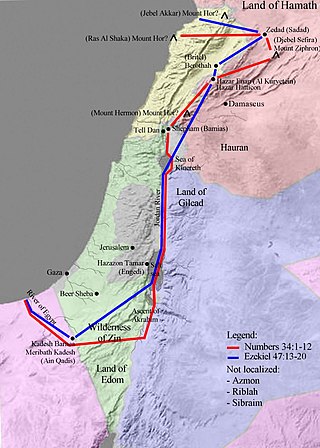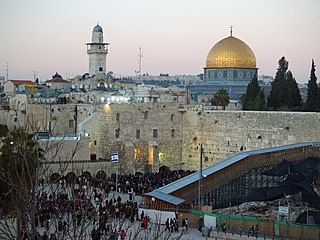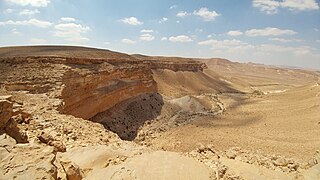This biography of a living person relies too much on references to primary sources .(September 2009) |

Emmanuel Anati (Florence, 14 May 1930) is an Italian archaeologist.
This biography of a living person relies too much on references to primary sources .(September 2009) |

Emmanuel Anati (Florence, 14 May 1930) is an Italian archaeologist.
Emmanuel Anati was born in Florence in 1930 to Ugo and Elsa Castelnuovo, a family of Jewish origin.
In 1948, he got the scientific maturity[ clarification needed ] in the "Righi" institute of Rome. He then moved to Jerusalem, where he graduated in archaeology from Hebrew University in 1952. In 1959, Anati specialized in anthropology and social sciences at Harvard University. In 1960, he earned a Ph.D. in Literature at the Sorbonne in Paris.
Anati has performed excavations and archaeological research in Israel (especially in the Negev desert), Spain, France, and other European countries. Based on the results of his discoveries in the Sinai Peninsula, Anati has become a supporter of the thesis that the Biblical Mount Sinai is not to be identified as Gebel Katherina, but as Har Karkom instead; he also believes that the Exodus should be placed between the 24th and the 21st century BCE, instead of the traditional date between 17th and 13th century BCE. [1]
This identification has not gained acceptiance: Israel Finkelstein (who denies the historicity of the Exodus) described Anati's methods as "an anachronistic vestige from the 19th century", while James K. Hoffmeier (who supports the historicity of the Exodus, but in the traditional 13th century date) has stressed that "the type of Early Bronze Age cultic installations discovered at Har Karkom have also been found in significant numbers in the southern desert, Negev, and Sinai—so Anati's finds are not unique". [2] [3]
In the 1950s, Anati explored Val Camonica, whose rock carvings are one of the largest sites for rock art in Europe. In 1964 he founded the Centro Camuno di Studi Preistorici (CCSP) in Capo di Ponte, in order to study the prehistoric and tribal art and contribute to the enhancement of this cultural heritage.
In 1962, he married Ariela Fradkin.

The Book of Exodus is the second book of the Bible. It narrates the story of the Exodus, in which the Israelites leave slavery in Biblical Egypt through the strength of Yahweh, who has chosen them as his people. The Israelites then journey with the prophet Moses to Mount Sinai, where Yahweh gives the 10 commandments and they enter into a covenant with Yahweh, who promises to make them a "holy nation, and a kingdom of priests" on condition of their faithfulness. He gives them their laws and instructions to build the Tabernacle, the means by which he will come from heaven and dwell with them and lead them in a holy war to possess the land of Canaan, which had earlier, according to the story of Genesis, been promised to the seed of Abraham.

The Israelites were a group of Semitic-speaking tribes in the ancient Near East who, during the Iron Age, inhabited a part of Canaan.

The Crossing of the Red Sea forms an episode in the biblical narrative of The Exodus.

The Negev or Negeb is a desert and semidesert region of southern Israel. The region's largest city and administrative capital is Beersheba, in the north. At its southern end is the Gulf of Aqaba and the resort city and port of Eilat. It contains several development towns, including Dimona, Arad and Mitzpe Ramon, as well as a number of small Bedouin towns, including Rahat and Tel Sheva and Lakiya. There are also several kibbutzim, including Revivim and Sde Boker; the latter became the home of Israel's first Prime Minister, David Ben-Gurion, after his retirement from politics.

Kadesh or Qadesh or Cades is a place-name that occurs several times in the Hebrew Bible, describing a site or sites located south of, or at the southern border of, Canaan and the Kingdom of Judah in the kingdom of Israel. Many modern academics hold that it was a single site, located at the modern Tel el-Qudeirat, while some academics and rabbinical authorities hold that there were two locations named Kadesh. A related term, either synonymous with Kadesh or referring to one of the two sites, is KadeshBarnea. Various etymologies for Barnea have been proposed, including 'desert of wanderings,' but none have produced widespread agreement.

Israel Finkelstein is an Israeli archaeologist, professor emeritus at Tel Aviv University and the head of the School of Archaeology and Maritime Cultures at the University of Haifa. Finkelstein is active in the archaeology of the Levant and is an applicant of archaeological data in reconstructing biblical history. He is also known for applying the exact and life sciences in archaeological and historical reconstruction. Finkelstein is the current excavator of Megiddo, a key site for the study of the Bronze and Iron Ages in the Levant.

The Exodus is the founding myth of the Israelites whose narrative is spread over four books of the Torah, namely Exodus, Leviticus, Numbers, and Deuteronomy. The majority of modern scholars date the composition of the Torah to the Middle Persian Period. Some of the traditions contributing to this narrative are older, since allusions to the story are made by 8th-century BCE prophets such as Amos and Hosea.

The Timna Valley is located in southern Israel in the southwestern Arava/Arabah, approximately 30 kilometres (19 mi) north of the Gulf of Aqaba and the city of Eilat. The area is rich in copper ore and has been mined since the 5th millennium BCE. There is controversy whether the mines were active during the biblical united Kingdom of Israel and its second ruler, King Solomon.
Kibroth Hattaavah or Kibroth-hattaavah is one of the locations which the Israelites passed through during their Exodus journey, recorded in the Book of Numbers. It was at this place, according to the biblical narrative, that the Israelites loudly complained about constantly eating only manna, and that they had enjoyed a much more varied diet, of fish, vegetables, fruit and meat, when they lived in Egypt; the text states that this led Moses, in despair, to cry out to Yahweh, who then promised them so much meat that 'they would vomit it through their nostrils'. The narrative goes on to tell of a huge number of quails brought by the winds to both sides of the Israelite encampment, which the people gathered. Modern translations imply that Yahweh sent the plague as they were chewing the first meat that fell

Mount Sinai is the mountain at which the Ten Commandments were given to Moses by God, according to the Book of Exodus in the Hebrew Bible. In the Book of Deuteronomy, these events are described as having transpired at Mount Horeb. "Sinai" and "Horeb" are generally considered by scholars to refer to the same place.

Tourism in Israel is one of Israel's major sources of income, with a record 4.55 million tourist arrivals in 2019, and, in 2017, contributed NIS 20 billion to the Israeli economy making it an all-time record. Israel offers a plethora of historical and religious sites, beach resorts, natural sites, archaeological tourism, heritage tourism, adventure tourism, and ecotourism. Israel has the highest number of museums per capita in the world. For practical reasons, this article also covers tourism in the Israeli-occupied West Bank and the occupied Golan Heights, since it is closely interconnected with the mass tourism in Israel.

Har Karkom is a mountain in the southwest Negev desert in Israel, half way between Petra and Kadesh Barnea. On the basis that the Israelites travelled across the Sinai peninsula towards Petra in a fairly straight line, a number of scholars have contemplated the possibility of Har Karkom being the biblical Mount Sinai. Following this theory, Emmanuel Anati excavated at the mountain, and discovered that it was a major paleolithic cult centre, with the surrounding plateau covered with shrines, altars, stone circles, stone pillars, and over 40,000 rock engravings.
According to the Book of Numbers, Taberah is one of the locations which the Israelites passed through during their Exodus journey. The biblical narrative states that the place received its name, which means the pӀace of burning, because the fire of the LORD had burned there in anger because of their continued complaints. The text states that the fire first burned at the outskirts of the Israelite camp, killing some of those who lived on the edge of the group, but it was extinguished when Moses prayed on the people's behalf.

The rock drawings in Valcamonica are located in the Province of Brescia, Italy, and constitute the largest collections of prehistoric petroglyphs in the world. The collection was recognized by UNESCO in 1979 and was Italy's first recognized World Heritage Site. UNESCO has formally recognized more than 140,000 figures and symbols, but new discoveries have increased the number of catalogued incisions to between 200,000 and 300,000. The petroglyphs are spread on all surfaces of the valley, but concentrated in the areas of Darfo Boario Terme, Capo di Ponte, Nadro, Cimbergo and Paspardo.

The Camunian rose is the name given to a particular symbol represented among the rock carvings of Camonica Valley. It consists of a meandering closed line that winds around nine cup marks. It can be symmetrical, asymmetrical or form a swastika.

Exodus: A Journey to the Mountain of God is a 1992 Israeli documentary film that follows an international group of archaeologists and travelers who go on a camel-back journey looking for the true location of the Biblical Mount Sinai. Arriving at Mount Karkom in the southern Negev Desert of Israel, they examine the archaeological findings discovered there by Italian archaeologist Prof. Emmanuel Anati. These findings are the basis for a theory claiming that the Biblical Mount Sinai is not Jabal Musa in Egypt, as some traditions claim, but Mount Karkom, and that this is where the Exodus took place. It also follows the expedition members' experiences and thoughts about religion, faith, human nature, and spirituality. Due to the remote desert terrain, the production equipment was hauled along the 160-kilometer (99 mi) expedition route by the crew and on camel-back.

The Bible makes reference to various pharaohs of Egypt. These include unnamed pharaohs in events described in the Torah, as well as several later named pharaohs, some of whom were historical or can be identified with historical pharaohs.
James K. Hoffmeier is an American Old Testament scholar, an archaeologist and an egyptologist. He was Professor of Old Testament and Ancient Near Eastern History and Archaeology at Trinity Evangelical Divinity School.
The Exodus is the founding myth of the Israelites. The scholarly consensus is that there was no Exodus as described in the Bible, even though there may be a historical core behind the Biblical narrative.
Biblical maximalism is the movement in Biblical scholarship that, as opposed to Biblical minimalism, affirms the historicity of central Biblical narratives, such as those pertaining to the United Monarchy, and the historical authenticity of ancient Israel as a whole. Due to differences between the Bible and 19th- and 20th-century archaeological findings, there exists discordance between the two parties of biblical exegetists: the biblical maximalists argue that prior to Judaism's Babylonian Captivity, the Bible serves an accurate historical source and should influence the conclusions drawn from archaeological studies; whereas biblical minimalists assert that the Bible must be read as fiction, unless proven otherwise by archaeological findings, and ought not be considered in secular studies.